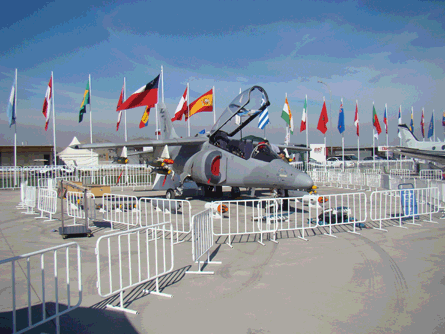Argentina is again looking at upgrading the engine powering the indigenous AT-63 Pampa following the renationalisation of the local company that produces the jet trainer.
The engine project could result in the next batch of 10 Pampas being delivered with the Honeywell TFE731-40, as well as re-engining all 18 of the TFE731-2-powered Pampas currently operated by the Argentinian air force. The AT-63 demonstrator is expected to be outfitted with the -40 engine within the next couple of months and test flights should begin later this year.
Lockheed Martin Aircraft Argentina (LMAASA) in the middle part of the last decade studied outfitting the Pampa with the TFE731-40, but the project never advanced to the test flight stage. The Argentinian government, which privatised the factory that produces the Pampa in 1995, took back control last December and has rebranded it as FAdeA.
 |
|---|
© FAdeA |
Pampas were first produced in the late 1980s and early 1990s, by the then FMA. LMAASA resumed production of the type last decade and delivered six additional aircraft featuring a new avionics configuration but the same engine. It also completed an avionics upgrade on the 12 Pampas that are still operating from the initial FMA-produced batch.
When the factory was handed back to the government several additional Pampas were in various stages of completion. FAdeA says there are now 10 Pampas in the production process, which it plans to outfit with TFE731-40 engines once the flight-test programme is completed. The aircraft will be delivered over the next two years.
FAdeA is also proposing to re-engine the original 18 aircraft and hopes the -40 will help bolster export interest in the Pampa, which has not been sold outside Argentina despite multiple attempts.
The -40 is about 20% more powerful than the -2 and LMAASA in 2005 promised an improvement in speed from about 340kt (630km/h) to 390kt. But FAdeA says it now plans to de-rate the -40 and only provide a slight increase in power with no major changes in speed, operating ceiling or other specifications.
FAdeA says the main benefit of the engine upgrade will be lower maintenance costs and improved supportability. The company's target is to double the time between maintenance intervals and extend the life of the engine.
Maintenance of the Pampa engine has been problematic, with lower reliability and higher maintenance costs than initially expected. FAdeA points out that the TFE731 was developed for the civilian market but in the military environment the engine is often running at maximum power as pilots use the Pampa to simulate dogfights.
By electronically de-rating a more powerful version of the TFE731 the same training flights can be sustained with less stress on the engine, resulting in lower maintenance costs and improved reliability, it says.
Source: Flight International




















